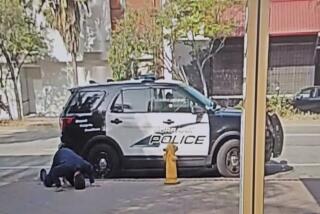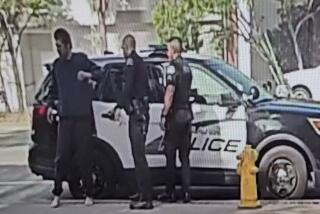Questions after homeless man’s lonely death
- Share via
Reporting from New York — Were it not for a surveillance camera, Hugo Alfredo Tale-Yax’s death may have passed as anonymously as his short life.
Instead, as he lay crumpled outside the doorway of an apartment building, bleeding from a stab wound to the chest, the camera recorded every excruciating minute: Tale-Yax staggering after being attacked, collapsing, then lying on the sidewalk for more than an hour as one person after another walked by without calling for help.
Most glanced curiously at the 31-year-old Guatemalan immigrant sprawled across the sidewalk in the working-class Queens neighborhood. Many slowed down. Someone took out a cellphone and snapped a picture of Tale-Yax before moving on. One man shook Tale-Yax vigorously, then rolled him over to reveal the blood beneath his chest before walking away.
By the time firefighters arrived nearly 90 minutes later, Tale-Yax was dead, leaving behind relatives, friends and strangers shaken by the behavior of people living in one of America’s safest big cities, where signs and announcements in public areas and subway stations urge people to report suspicious activity.
Less than two weeks after Tale-Yax’s April 18 death, bystanders quickly alerted police to a suspicious vehicle in Times Square, preventing what officials said could have been a devastating car-bomb blast and further highlighting the disinterested behavior toward Tale-Yax.
“With each person who walked by, a little more of our humanity slipped away,” said Kevin Dotson, one of several strangers to the Tale-Yax family who made the trip to Brooklyn to attend a wake for the slain man.
Tale-Yax, who had come to the United States six years ago, lay in an open casket draped with red and white carnations. A dark suit and yellow tie covered his wounded chest, and his black hair fell across the white cushions. “Descance en Paz,” read a note beside the coffin. Rest in Peace.
Cousins, brothers and other relatives milled about, speculating on the reasons for Tale-Yax’s lonely death. None saw the pedestrians’ inaction as a uniquely New York trait. Rather, they said it was evidence that New Yorkers, like people across the country, are so concerned with their own problems that they ignore other people or blame them for their woes.
People like Tale-Yax, an immigrant who in recent months had become homeless, are prime scapegoats, said the family’s pastor, Rev. Luis Fernandez.
During the six-hour wake on April 28, which was paid for by the Guatemalan Consulate, Fernandez delivered a passionate sermon in Spanish, the mother tongue of most people at the funeral home.
“My community is here to work,” said Fernandez, who says Arizona’s passage of strict anti-illegal-immigration legislation and a series of hate crimes against Spanish-speaking immigrants in New York are evidence of the disdain some people have for them.
“You see what happened in Phoenix,” said Fernandez, referring to the Arizona law. “The people here know about that, and when they saw Hugo they’re probably thinking he’s a criminal. They’re not thinking of him as a man who needs help.”
Police received 911 calls after Tale-Yax’s stabbing. One reported a woman screaming, and one reported a possibly injured man. But both sent police to the wrong address, and it’s clear from the video that the overwhelming majority of passers-by made no attempt to call for help.
One of Tale-Yax’s brothers, Rolando, 28, said he was mystified as to why the woman involved in the incident, who apparently was under threat from an unidentified male until Tale-Yax intervened, has not come forward to identify the stabber.
“I’d ask her: ‘Why didn’t you call? Why didn’t you help?’ ” Rolando said.
Police have yet to find the woman, or the man with whom she was arguing that night, despite airing the video taken from a nearby building’s surveillance camera that showed the pair.
The images are grainy but clear enough to see the squabbling couple: a young woman with long, dark hair in a short skirt and jacket and a man in a short-sleeved shirt and cap.
“She may only be alive today because he [Tale-Yax] stopped someone from hurting her,” said Rosa Akidil, who did not know the slain man but came from Manhattan’s Upper West Side to sit in the front row at the wake and pay her respects.
Like many New Yorkers old enough to remember it, Akidil said the case was reminiscent of the slaying of Kitty Genovese in 1964. Genovese was 25 when she was raped and stabbed on a Queens street. Most of the people who heard her screams did not call police, and the case became a symbol of what many considered New Yorkers’ unique level of callousness. It also prompted studies into reasons behind bystander apathy.
Dr. Paul Fink, a psychiatry professor at Temple University and a past president of the American Psychiatric Assn., said Tale-Yax, like Genovese, may have been doomed because, unlike the vendors who reported the Times Square car bomb, people who saw Tale-Yax or heard Genovese were not in peril themselves.
“If you feel endangered, you’re going to do whatever you have to do to help yourself,” said Fink, adding that the tendency is the same whether you live in New York or a small town.
Even Tale-Yax’s relatives and other mourners at the wake admitted that they rarely stop to check the well-being of someone lying on a sidewalk in New York City, where the homeless population is in the tens of thousands and where immigrant workers fear ending up in jail if their working papers are not in order.
“I’ve been there,” said Byron, 24, one of Tale-Yax’s brothers, who acknowledged that fear could have prevented people from alerting police to his sibling’s situation. Still, he said, “human beings are supposed to help each other.”
Byron is one of the five Tale-Yax brothers, two sisters and several cousins who made their way to the United States separately over the years, all for the same reason.
“Everyone is trying to get a better life,” he said as people continued to file past the casket. Asked if he planned to remain in the United States, he said, “I’ll make a decision after this.”
More to Read
Sign up for Essential California
The most important California stories and recommendations in your inbox every morning.
You may occasionally receive promotional content from the Los Angeles Times.











